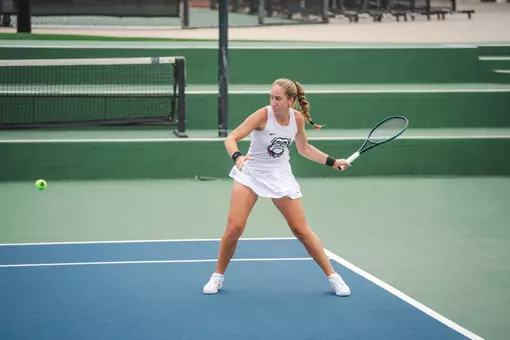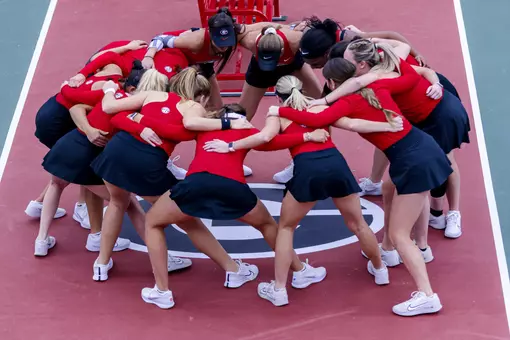University of Georgia Athletics

Fast Starts Required In Doubles
March 15, 2016 | Women's Tennis
By John Frierson
UGAAA Staff Writer
The return of no-ad scoring to collegiate tennis last year brought an exciting twist to tight matches. At 40-all in any game it was suddenly winner-take-all on the next point. It added speed and drama, which all sports are looking for these days.
A new twist has been implemented in doubles this spring, one that adds speed and potential drama, but also ups the pressure from the very first point. In the new format, implemented by the Intercollegiate Tennis Association this season for men's and women's dual matches, each of the three doubles matches consist of a single set. First one to six games, win by two — just like in singles.
Up until the 1990s, doubles was played after singles and it was two out of three sets. Then, to shorten the matches and maybe make it more TV friendly, the doubles was played first and shortened to an 8-game pro-set, which is what teams have played until this season. (They also played it during individual events in the fall).
In the pro-set, all four participants served at least twice and there was certainly time to recover from a slow start. It wasn't a marathon, but it was at least like a 5K race. Now, in comparison, doubles is more like a 400-meter dash.
"It's pretty quick," said Paul Oosterbaan, who plays No. 3 doubles for the Georgia men's team. "One or two bad points and you can lose the match in 15 to 20 minutes. I think you've got to come out with energy from the start, otherwise you can lose pretty quickly."
Bulldogs men's coach Manuel Diaz played for the Dogs in the early 1970s, when there was no-ad scoring and full-length doubles matches after singles play. He described the new format as "Russian roulette," and said he had mixed feelings about it.
"I know it's exciting and actually keeps the crowd here," Diaz said. "We used to lose about 40 or 50 percent of our crowd after the doubles, because it was rather long, over an hour most times. Now, it's great that everybody stays, and it's like an appetizer, not the main course.
"But at the same time, with no-ad and just to six, it's so fast. The best team doesn't always win, ever, but I think even more so now."
The No. 19 Bulldogs have won the doubles point in nine of 12 matches this season, including their past six, while the No. 4-ranked Georgia women have clinched the doubles point in nine of 11 matches.
In the Georgia women's two matches over the weekend, against Alabama and then-No. 11 Auburn, the Lady Bulldogs won both doubles points en route to easy match victories. Against the Tide, Georgia showed just how quickly matches can go if you start out well.
At No. 1 doubles, Ellen Perez and Mariana Gould cruised to a 6-2 win, and soon after the point was clinched by Caroline Brinson and Silvia Garcia, who won 6-1 at No. 2. On court 3, Kennedy Shaffer and Laura Patterson were leading 5-2 and two points from victory when the doubles point was secured.
"Two games shorter, you wouldn't think it would make that much of a difference, but it really does," said Perez, who played in the Australian Open doubles earlier this year. "It's a lot quicker and you've got to get off to a good start. It really helps when you can serve first and get that early lead.
"You're pressured right from the start so you better start well."
Like Diaz, Georgia women's coach Jeff Wallace played for the Dogs (in the early 1980s) using the older format. And like Diaz, Wallace isn't sure he likes how doubles keeps getting cut shorter and shorter. The new format is what everyone is playing this season, Wallace said, and you've got to embrace it and adapt to it.
"It's short and anything can happen, and it's a super big equalizer," he said. "You've got to stay focused and engaged every single point, and bring it and have tons of energy. You have to realize that it's going to be quick and it's going to be over."
Shaffer said she likes how the new format forces you to not only start fast, but also process a lot of information quickly.
"You have to be a problem solver, you have to be passionate, you have to play with purpose and be competitive," she said.
If you don't, you or your partner's serve can quickly get broken and that can be that. Wallace said his squad hasn't changed any of their pre-match routines to adjust to the new system. The pro-set didn't leave a ton of margin for error, either, so what applied then still applies now.
"Our big thing is: a lot of energy, ready to go with the game plan and just get after it, and play smart right from the beginning," he said.
If you watched college tennis in the old format, when doubles followed singles, it was the sport at its finest. Singles is the main course, what players want to play and what people in the seats want to watch, and you usually got to see all six matches played all the way through. And then, sometimes, you got to see a tight match continue with the doubles.
The matches were long, yes, but so is a college football game, so is a day on the course at a golf tournament. The old format was demanding, but also brought everything into play: skill, strategy, concentration and fitness.
Diaz said studies showed that doubles wasn't being played often enough in the old system, though he'd love to see a return to it — even though he knows that's not likely to happen.
"I still think it would be similar to penalty kicks in soccer," he said of turning to doubles after the match wasn't decided in singles. "It would be exciting; who the heck is going to leave when you're 3-3 and you take a 5-minute break and come out for three doubles matches?"
How's this for an idea: instead of playing a six-game set of doubles to start the match, you play the singles first and then if the match isn't decided after singles you have the doubles teams play super-tiebreakers (first one to 10, win by two)? It's an idea that has been brought up before, Diaz said.
"That would be amazing, super exciting," he said. "I was kind of for that, but I thought a whole lot of people thought we wouldn't be playing enough doubles. And that's valid."
Wallace said different formats are frequently being discussed by coaches as college tennis tried to pick up the pace of the matches and put fans in the seats, while also trying to figure out how to make it television friendly. This is what teams are playing this season and players better be fast out of the starting blocks, or else there might not be time for a comeback.
John Frierson is the staff writer for the UGA Athletic Association and curator of the ITA Men's Tennis Hall of Fame. You can find his work at: Frierson Files. He's also on Twitter: @FriersonFiles and @ITAHallofFame.










